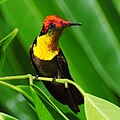Taxonomy
A molecular phylogenetic study of the hummingbirds published in 2007 found that the family consisted of nine clades. [2] When Edward Dickinson and James Van Remsen, Jr. updated the Howard and Moore Complete Checklist of the Birds of the World for the 4th edition in 2013 they divided the nine clades into six subfamilies and proposed using the Latin name Polytminae for the "mango" clade, a name that had been introduced by Ludwig Reichenbach in 1849. [3]
Pre-molecular studies did not anticipate the existence of this clade, but a common feature is the presence of serrations on the cutting edge of the bill. An extreme example is the tooth-billed hummingbird (Androdon aequatorialis). [5]
Molecular phylogenetic studies by Jimmy McGuire and collaborators published between 2007 and 2014 determined the relationships between the major groups of hummingbirds. [6] [2] [7] In the cladogram below, the English names are those introduced in 1997. [8] The Latin names are those proposed by Dickinson and Remsen in 2013.
The phylogenetic relationships between the genera in the subfamily Polytminae, as determined in the 2014 study, are shown below. The genus Eulampis was found to be nested within Anthracothorax , making Anthracothorax paraphyletic. [5] [6] No species from the genus Augastes was sampled in the molecular studies, but based on a comparison of plumage features and bill shapes, it is believed that Augastes is closely related to Schistes. [5]
This page is based on this
Wikipedia article Text is available under the
CC BY-SA 4.0 license; additional terms may apply.
Images, videos and audio are available under their respective licenses.












